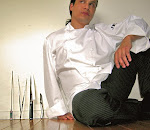

Toro tuna, Soffrito ice cream, ginger oil, ponzu water gelee
Steamed arctic char, spiced duck confit, onion flan cremeaux, dried cherry syrah butter, Napa cabbage gnocchi
Sometimes a very fresh piece of fish doesn't need alot of ingredient clutter to barricade it's pristine taste. Where different schools of thought have their own views on this, I like to experience new flavor combinations or directions to fish. Knowing the fat content is one process on dictating it's technique for cooking the fish. Fish with a high fat content such as salmon, tuna, Alaskan halibut, or arctic char can benefit from slow roasting, oil confit cooking, or pan roasting. A low fat fish such as flounder, sole, striped bass, or red snapper could benefit from a low heat steaming or a cold poaching method.
Whatever the cooking method, being aware of the internal temperature is crucial. The best way of determining this is using a digital thermometer. If you do not have one, try not to use your finger and push the flesh of the fish. Fish can be quite delicate and this action may damage the fish. Alternately, use a thin metal cake tester. Measure the distance from the edge of the fish to the center. Gently insert the skewer and leave for 3 or 4 seconds. Pull out the skewer and place it under your bottom lip. The skin here is sensitive to temperatures. If the skewer is cold, the fish is still raw. If is is warm, the fish is cooked perfectly. If the skewer is hot, the fish is most likely overcooked. Always allow the fish to rest for 5-10 minutes to ensure it's moistness. Ideal internal temperatures should be
135F (57C)-140F (60C).






